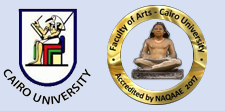عنوان المقال عربي
تحليل تشبيهات "يوم القيامة" الحقيقيّة في الخطاب القرآنيّ على ضوء مفهوم التواصل الإظهاريّ الاستدلاليّ
Document Type
Original Study
Keywords English
True similes, communication, Relevance Theory, cognitive linguistics, Qur’anic studies
Abstract English
This study attempts to unfold inputs (stimuli) and outputs (assumptions) of the cognition process of Qur’anic true similes, by utilizing ostensive-inferential communication concept, which is basically a relevance-theoretic term. This study is divided into two sections; the first provides for clarity of the cognitive features of the true simile, and illustration of the concept of ostensive-inferential communication. The second section provides for the application of the study’s theoretical premise by scrutinizing ostension and inferential process of true similes via the contextual realization in Quran discourse. The study, through adapting a descriptive and a qualitative methodologies, selected five verses from the Holy Quran, which hold representations of the tremendous cataclysm scenes of the Doomsday, via constructing resemblances between “men and moths”, (Al-Qari’a :3) mountain and carded wool” (Al-Qari’a: 4), sky and molten brass or dregs of oil” (Al-Ma’arij: 8), “rolling up heavens and a scroll rolled up for books” (Al-Anbiya’:104) and “sky and ointment” (Ar-Rahman:37). This study finds that the perception and the propositional, informative and inferential construction of true simile are different from literal simile and metaphor. It further reveals that Qur'anic true similes are used as a cognitive tool, that facilitate inferential and interpretative processes via its communication of abstract and unseen and nuanced themes of God’s message to its audience. Moreover, similes contain relevant vehicles, as they are driven from audiences’ cognitive environment, have strong ostensive stimuli with strong contextual effects, and easy assumption accessibility for audiences, to grasp the intangible scenes and infer the communicator intentions with the least exert cognitive efforts.
الملخص العربي
تناولت هذه الدراسة مدخلات العمليّة الإدراکيّة ومخرجاتها في مقولات التشبيه الحقيقيّ (أو المجازيّ)، من منظور مفهوم التواصل الإظهاريّ الاستدلاليّ في نظرية الصلة؛ لکي تتبيّن خصائص المنبّهات الإظهاريّة في التشبيهات الحقيقيّة القرآنيّة، وتأثيراتها السياقيّة بتکوين المخاطَبِ افتراضاتٍ ذهنيّةً تمکّنه من التصوّر والتخيّل والاستدلال. وجاءت الدراسة في قسمين: قدّم القسم الأول الإطار النظريّ، وشمل خصائص التشبيه الحقيقيّ الإدراکيّة، ومفهومَ التواصل الإظهاريّ الاستدلاليّ في نظرية الصلة. أما القسم الثاني فقدّم تحليلا لخمس آيات کريمة، تصوّر أحوالَ الناس والجبال، والسماء، في مشهدين من مشاهد "يوم القيامة": مشهد القارعة، ومشهد انشقاق السماء. وتقوم الدراسة على المنهج الوصفيّ في تحليل ظاهرة التشبيهات على المستوى البراغماتيّ، وتمثل مادتّها المستقاة من القرآن الکريم أرفعَ نماذج العربية الفصحى وأعلاها منزلة، وتعتمد الدراسة على مفهوم التواصل الإظهاريّ الاستدلاليّ، وهو أحد المفاهيم المرکزيّة في نظرية الصلة، وتستفيد من معطيات اللسانيات المعرفيّة، وأنظار المشتغلين في نظرية الصلة.
Recommended Citation
Abu Khader, Saeed Jabr
(2020)
"The True Similes of Doomsday into Qur'anic Discourse: An Analysis Based on Ostensive-Inferential Communication Concept.,"
Journal of the Faculty of Arts (JFA): Vol. 80:
Iss.
4, Article 10.
DOI: 10.21608/jarts.2020.135393
Available at:
https://jfa.cu.edu.eg/journal/vol80/iss4/10
Digital Object Identifier (DOI)
10.21608/jarts.2020.135393
Accept Date
2020-06-04
Publication Date
10-1-2020

